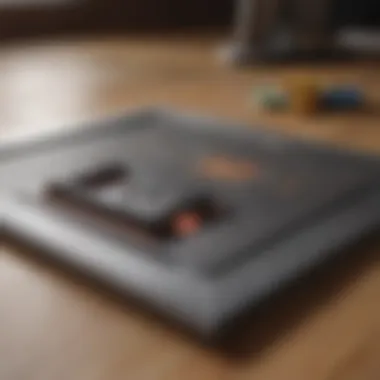Calculating Flooring Needs for Your Space


Intro
Calculating flooring needs is vital for any construction or renovation project. Whether one is a homeowner looking to refresh a living space or a professional managing large-scale projects, understanding how much flooring is required shapes the success of the endeavor. Getting accurate measurements informs buying decisions, minimizes waste, and ensures a flawless finish.
A fundamental aspect to begin with is square footage. Yet, it is not merely about measuring the area. Several factors can affect the amount of flooring materials needed, such as the type of flooring, layout, and any unique design elements. This article seeks to dissect these intricacies, guiding readers in making informed choices crucial in meeting both aesthetics and functionality.
Consideration of flooring materials is worthwhile too. Different materials, like hardwood, laminate, or tile, present various requirements for installation. Each has its characteristics, adding complexity to the equations involved. Miscalculations can lead to unnecessary expenses and delays, making it crucial to tackle the process with precision.
The combination of sound measurement techniques with an awareness of materials ensures a smoother project execution.
With this perspective established, let's explore the key components to calculating flooring needs.
Understanding Flooring Requirements
Understanding flooring requirements is foundational for a successful flooring project. Accurate calculations will ensure that your flooring fits perfectly within the designated space and helps to avoid wastage. This section focuses on the significance of proper measurements, the common pitfalls encountered during the flooring process, and ways to prevent these issues. Taking the time to grasp these concepts can ultimately influence the outcome of your project, both in aesthetic and functional terms.
The Importance of Accurate Measurements
Accurate measurements serve as the backbone of any flooring installation. They determine the amount of material needed and ensure that everything fits as planned.
A small miscalculation can lead to purchasing too much or too little material. This not only affects your budget but can also delay the project. For instance, if you underestimate the square footage, you may find yourself needing additional planks or tiles, which may not match exactly due to color or texture variations. Conversely, overestimating can result in wasted resources and increased costs.
In order to achieve precise measurements, it is essential to consider both the dimensions of the floor and any irregularities in the layout. Floors rarely have perfect shapes. Allow for any nooks, corners, or architectural features that might alter your calculations. Additionally, ensure you measure at least twice to confirm accuracy. This diligence prevents common errors that can be costly in terms of both time and materials.
Common Flooring Mistakes to Avoid
Despite careful planning, mistakes can occur. Here are some of the most frequent errors to be cautious of:
- Neglecting to Account for Waste: It is essential to include extra material for waste. This could arise from cutting or installation errors, thus increasing your material needs.
- Ignoring Subfloor Conditions: Changes in the subfloor can affect the type of flooring you choose or how much you purchase. Inspect its condition and ensure it meets the requirements of your desired flooring material.
- Not Considering Acclimation Needs: Some materials, particularly hardwood, require acclimation before installation. Failing to do so can lead to problems such as warping or buckling.
- Misjudging Room Shape: Measure each section of an irregularly shaped room carefully. Failure to do this can complicate the installation process and leave areas unaccounted for.
By being mindful of these common mistakes, you position yourself for a smoother project. Making informed decisions based on accurate assessments is pivotal in minimizing issues and maximizing investment.
Calculating Square Footage
Accurate calculations for square footage are fundamental to any flooring project. When embarking on such a task, it is vital to understand not just the total area to be covered but also how measurement translates into material costs and project efficiency. Miscalculations lead to increased expenses and wasted resources.
The importance of this section can not be overstated. Knowing your square footage helps in estimating the amount of flooring material required, thus avoiding excess or deficiency, which can disrupt timelines and budgets. Moreover, it serves as a basis for understanding the specific needs of various spaces, which inherently differ by use and layout.
In this section, we will delve into three critical aspects: measuring room dimensions, understanding area calculations, and using measurement tools effectively.
Measuring Room Dimensions
To accurately measure room dimensions, start by gathering essential tools, including a measuring tape, notepad, and possibly a digital level. Clear the area of any furniture or obstacles for better access. Measure each wall, recording the length and width. If the room has unique shapes, like alcoves or unusual angles, it may be helpful to divide these into smaller rectangular sections and calculate their areas separately.
Ensure you measure from wall to wall, not just along the floor, as this will account for any variations in wall alignment. Take note of features such as built-in cabinets or doorways, as these can affect both the usable space and the amount of flooring needed.
Understanding Square Feet and Area Calculations
Area calculations are the bridge between mere measurements and actionable flooring needs. To calculate the area, multiply the length by the width for each individual section. For instance, if a room measures 10 feet by 12 feet, the calculation is straightforward:


However, for rooms with multiple shapes or features, aggregate the areas together. It’s also important to remember units, as most flooring materials are sold in square feet.
Additionally, when considering different types of flooring, understand how the layout could affect exact measurements. For example, tiles might require additional space for grout lines, while carpet might need to consider pile height.
Using Measurement Tools Effectively
Employing the right tools enhances precision. Beyond a simple measuring tape, consider using a laser distance measurer for quick and accurate results. These devices can be particularly useful for larger spaces. While a digital level ensures that your measurements are accurate, a graph paper can help visualize spaces effectively, allowing for better planning.
As you take measurements, always double-check your results. Small errors can magnify when calculating square footage, leading to significant discrepancies. Also, using apps designed for space calculation might help streamline the process and reduce human error.
"Investing time in accurate measurements can save both money and headaches in your flooring projects."
Accurate calculations are the linchpin of a successful flooring project. Focus on careful measurement techniques, understand area calculations thoroughly, and employ effective tools. Doing so will ensure a smoother renovation journey with minimized risks of error.
Factors that Influence Flooring Needs
Understanding the various factors that influence flooring needs is critical for successful flooring projects. Each element plays a role in deciding the final choices and materials. The size of the room, layout, and intended use can significantly affect the quantity and type of flooring required. By taking into account these considerations, homeowners and professionals can make more informed decisions.
Room Shape and Layout
Room shape and layout are vital when you calculate flooring requirements. A square or rectangular space is straightforward to measure and estimate. However, irregular-shaped rooms can complicate measurements. It’s essential to break down complex areas into smaller sections, enabling easier calculations. Moreover, understanding how room layout affects traffic flow can influence the selection of flooring types. For instance, high traffic areas might need more durable materials.
Irregular shapes often require more calculations and can lead to increased waste if not approached carefully. Remember to measure any alcoves, nooks, or indentations in the walls. Not only does this give an accurate square footage, but it also prevents the need for backtracking to purchase extra tiles or planks later on.
Considerations for Different Flooring Types
Hardwood
Hardwood flooring is popular due to its aesthetic value and durability. One major aspect is its ability to enhance the warmth and character of a room. The key characteristic of hardwood is its range of finishes and species, offering numerous design options. For instance, oak and maple are widely favored for their resilience.
The unique feature of hardwood is its longevity. When maintained properly, it can last for decades. However, one disadvantage is susceptibility to moisture and scratching. Thus, it may not be the best choice for bathrooms or kitchens unless specifically treated.
Tile
Tile flooring is another widely used option, especially in areas that require water resistance. Its durability makes it suitable for high humidity spaces like bathrooms. A key characteristic of tile is its versatility in design. The possibilities are vast, with various colors and patterns available.
Tiles are also easy to clean, making them a beneficial choice for homeowners with busy lifestyles. However, a downside can be the cold surface underfoot, which might not be comfortable in living areas. The installation process can also demand careful attention to detail, as uneven tiles can create bumps.
Carpet
Carpeting creates a cozy atmosphere, showing its appeal in bedrooms and living rooms. One essential aspect is its softness, making it comfortable to walk on. Additionally, carpets can add sound insulation, which is beneficial in multi-story homes.
Though popular, carpets can harbor allergens, making them less favorable for individuals with respiratory issues. Furthermore, they may require regular cleaning and maintenance to keep them looking their best.
Vinyl
Vinyl flooring has grown tremendously popular because of its affordable nature and ease of installation. This material's key characteristic is its resilience against scratches and stains, making it ideal for busy households. Additionally, vinyl is often waterproof, making it a practical choice for kitchens and bathrooms.
A unique feature of vinyl is its ability to mimic other materials like wood or stone effectively. However, while it is durable, it may not last as long as hardwood or tile in high-traffic areas. Therefore, knowing the expected wear can help those planning flooring projects make wise decisions.
Estimating Waste and Additional Needs
Estimating waste and additional needs is an essential part of any flooring project. It's standard practice to add around 10% to 15% more material to the calculated square footage. This account for possible mistakes during installation, cuts needed for specific angles, and waste from damaged pieces.


Different flooring types also address waste differently. For carpentry projects, such as with hardwoods, small cuts can add up quickly. Thus, it's important to be vigilant about this aspect during calculations.
To sum up, evaluating these factors significantly affects the total quantity of flooring materials needed. Being observant of room shape, layout, flooring types, and proper waste estimation leads to a smoother project execution.
Standard Flooring Measurements
Understanding standard flooring measurements is critical for any flooring project. This section highlights why precise measurements are necessary, benefits and consequences of inaccuracies, as well as standard practices to follow. Missing the mark in measurement can lead to excess materials, waste, or worse, insufficient coverage.
When embarking on a flooring project, knowing the standard dimensions and requirements of common rooms can guide purchasing decisions. For example, each space in the home has a typical size correlating with expected flooring needs. Knowing these can help to plan and budget more effectively, allowing for potential savings or avoidance of expensive errors.
Common Room Sizes and Their Requirements
Different rooms have common dimensions, but these can vary significantly based on home design. Here are some standard sizes:
- Living Room: Typically ranges from 200 to 400 square feet, depending on layout and space.
- Bedroom: A standard bedroom usually measures between 100 and 300 square feet.
- Kitchen: Average kitchens are often around 150 to 300 square feet.
- Bathroom: Standard bathrooms frequently fall between 40 and 100 square feet.
Knowing these dimensions assists in determining how much flooring is needed. For instance, if a bedroom measures 12 by 14 feet, it covers 168 square feet. Adding for waste, you might want to consider purchasing materials for around 175 square feet.
Calculating for Multiple Rooms
When calculating flooring needs for multiple rooms, a systematic approach is beneficial. First, measure each room independently, following the steps outlined earlier, and then total the individual square footages. Consider the following steps:
- List each room's dimensions. This can be easily done with a simple spreadsheet or paper format.
- Calculate individual square footage. For instance, a 10 by 12-foot room is 120 square feet.
- Sum the totals. This provides a broader picture of the total flooring needed for the entire project.
- Consider overlaps or obstructions. Check for areas that may not require flooring, such as built-in cabinets or fixtures.
Ensuring accurate and comprehensive measurements across all rooms can significantly improve the outcome of your flooring project.
In summary, by understanding standard flooring measurements and knowing how to calculate needs for individual and multiple spaces, homeowners and project managers can navigate their flooring projects with confidence and precision.
Tools for Calculating Flooring Needs
Understanding how to calculate flooring needs effectively is vital for anyone involved in home improvement or renovation projects. The right tools can simplify the process of determining the correct amount of flooring material required. They help avoid mistakes that can lead to wasted resources and time. Selecting the appropriate tools can enhance accuracy and efficiency, making the project less stressful and more enjoyable.
Online Calculators and Apps
In today's digital age, online calculators and mobile applications have revolutionized how homeowners and professionals calculate flooring needs. These tools offer user-friendly interfaces and an array of features that can make the measurement process swift and efficient.
Some commonly used online calculators allow users to input room dimensions and automatically calculate the total square footage. This is especially helpful for those who may not be comfortable with manual calculations. Additionally, many of these calculators take into account factors such as waste and patterns in the flooring layout, which can significantly affect the final quantity needed.
Benefits of Online Calculators:
- Ease of Use: Many calculators provide guided steps. Users can follow along easily without prior knowledge.
- Accuracy: Algorithms built into these tools often handle complex calculations flawlessly. This minimizes the risk of human error.
- Instant Results: Online calculators yield quick results, allowing for faster decision-making.
- Flexibility: Apps can facilitate calculations on-site, making it easier to adjust measurements based on immediate observations.
However, it is important to choose reliable calculators. Checking reviews and ensuring that the source is trustworthy can save users from miscalculations. Some reputable websites that offer such calculators include popular home improvement platforms.
Manual Calculation Techniques
For those who prefer a hands-on approach, manual calculation techniques can also be effective for determining flooring needs. This method might require more effort, but it provides a stronger grasp of the overall project.
To begin, one must first accurately measure the dimensions of the room. Using a tape measure, note the length and width of the space in feet. The formula to find the area in square feet is straightforward:
Area = Length × Width


For example, if a room measures 12 feet in length and 10 feet in width, the calculation would be:
This method allows for easy adjustments if the room has irregular shapes. In such cases, divide the area into smaller rectangles or shapes and sum their individual areas.
Key Considerations in Manual Techniques:
- Precision in Measurement: Double-checking measurements helps prevent underestimations or overestimations.
- Waste Estimation: It is also wise to include an additional percentage (usually around 10%) for waste due to cuts or miscalculations.
- Understanding Units: Ensure you are consistent with units; mixing feet and inches can cause significant errors.
Both online tools and manual techniques have their own advantages. The choice between them often comes down to personal preference. Regardless of method utilized, being methodical in calculations can yield a successful flooring project.
Consulting Professionals
Consulting professionals during a flooring project can have significant impacts on the outcome, both in quality and efficiency. Their expertise brings a wealth of knowledge that can streamline the entire process. Whether you are looking to install hardwood, tile, carpet, or vinyl flooring, professionals offer insights that can save time and resources. They can also ensure that your project adheres to local building codes and safety standards, which is essential in avoiding legal issues in the future.
In addition to project compliance, seasoned professionals can assess your specific needs based on factors like room dimensions and expected foot traffic. This tailored approach can prevent common mistakes and lead to more satisfying end results. Furthermore, working with experts can provide access to resources and materials that may not be readily available to the average homeowner, enhancing the overall quality of your flooring solution.
When to Seek Expert Help
There are several circumstances that may indicate it's time to consult an expert:
- Complex Room Layouts: If your project involves irregular shapes or significant architectural features.
- Specific Material Expertise: When working with specialty flooring materials such as engineered wood or exotic stones.
- Installation Challenges: If you face obstacles like uneven subfloors or require advanced techniques.
- Budget Constraints: When your project budget is tight and you need to maximize every dollar spent.
Recognizing these signals early can save you from costly mistakes that might arise from a DIY approach or insufficient planning. Knowing when to bring in an expert could well be the difference between a well-executed project and an arduous endeavor laden with setbacks.
Choosing the Right Contractor
Selecting the right contractor is a critical step in ensuring the success of your flooring project. Here are a few essential factors to consider:
- Experience and Credentials: Look for contractors with proven experience in flooring installations similar to yours. Verify their licenses and certifications to ensure they meet industry standards.
- Reviews and References: Collect testimonials from previous clients. Online platforms can provide valuable insights into the contractor's reputation and reliability.
- Detailed Estimates: A trustworthy contractor should be able to offer a comprehensive estimate that includes labor, materials, and potential additional costs.
- Communication: Ensure that the contractor is approachable and communicates effectively. Establishing a good working relationship can facilitate a smoother project flow.
In summary, taking the time to thoroughly research contractors can lead to a successful and hassle-free flooring project. It is vital to align with someone who understands your vision and offers a strategic approach to meet your needs.
Final Thoughts
Reflecting on the importance of calculating flooring needs highlights the intricate balance between precision and practicality. Accurate calculations not only save time and money but also align perfectly with the intended design and functionality of a space. Understanding this topic empowers homeowners and professionals alike to make informed decisions that enhance aesthetics and utility.
As you consider your flooring project, bear in mind that the process is not merely about selecting materials or colors. It involves a comprehensive approach to planning, measurement, and factor assessment. Each room’s layout, the type of flooring chosen, and any additional needs can significantly alter the final requirements. Therefore, taking the time to establish a solid foundation through precise calculations is essential.
"Failing to plan is planning to fail." It rings true in flooring projects where incorrect estimations can lead to costly mistakes.
By integrating the key principles explored in this article—from measuring techniques to utilizing tools effectively—you can navigate through decisions with greater confidence. With careful assessment and strategic planning, you unlock the potential for a successful flooring transformation.
Summary of Key Points
Several core elements crystallize from the discussions in this article:
- Accurate Measurements: Always begin with precise dimensions of the space to avoid discrepancies in material needs.
- Estimating Waste: Recognizing that wastage occurs helps in adjusting your requirements and ensures you have sufficient materials.
- Understanding Material Requirements: Each flooring type has unique characteristics, affecting both the laying process and maintenance.
- Using Professional Help When Needed: Consulting experts can clarify complex aspects of your project and provide tailored solutions.
These points provide a solid guideline as you prepare for your flooring endeavors.
Next Steps in Your Flooring Project
Embarking on a flooring project involves subsequent actions following your calculations:
- Finalize Your Budget: Establish how much you are willing or able to spend on both materials and labor.
- Select Flooring Type: Based on the aesthetic and functional requirements you outlined, choose the flooring type—be it hardwood, ceramic tile, or vinyl.
- Procure Materials: Once you have selected the flooring type, purchase the required materials, remembering to account for additional waste and future repairs.
- Scheduling Installation: Coordinate timelines for installation with your contractor or as a personal project, ensuring minimal disruption to your daily life.
- Plan for Finishing Touches: After installation, consider how furniture placement and decor can complement your new flooring.
Ultimately, each of these steps necessitates strategic thinking and planning throughout your flooring project. Preparing efficiently can lead to a more successful outcome, transforming your space into what you envisioned.















